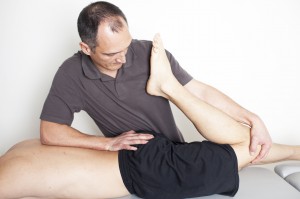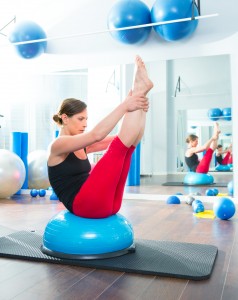“Take care of your body. It’s the only place you have to live.”
– Jim Rohn
When attending physiotherapy sessions, we will not only have you perform exercises in the clinic but also issue some exercises to perform at home. Physiotherapy exercises are used to increase circulation, decrease muscle spasms, improve muscle strength and activation, and restore your body to its natural state of functioning properly. All good stuff! Not only are they great at keeping you healthy they are also one of your best tools when recovering from an injury. Gone are the days when you are injured and told to just rest for 2-3 weeks… or sometimes longer. Time to get off your butt and take an active role in helping your body recover! Here are some of the most common types of physiotherapy exercises.
 Stretching
Stretching
Stretches consist of holding a muscle in its lengthened position to increase your flexibility. It will help loosen tight muscles to restore natural joint movement. Often times, tight muscles are the primary cause of muscle strains, or tears. Tight muscles can limit normal movement which overtime will increase the wear and tear on joints, even if the tight muscle is not near the injury or painful area. Ever have knee or ankle pain with running? Check the flexibility in your hips! Your hip muscles control much of the mechanics in your legs while walking or running. Stretching can also help to improve your posture, therefore reducing back pain or soreness in your neck from working on your computer all day.
Resistance exercises
These are exercises that are performed with some type of resistance. The resistance can be from a variety of things such as gravity, weights, or elastic bands. Your body responds to stress placed on it. And when you make your muscles do something that they are not used to doing they respond by getting stronger. As we get older, if we or no longer challenge our muscles by not exercising or if we are performing only the same activities day in and day out, our muscles adapt to this and no longer grow. And more likely will get weaker. So if you sit at a computer desk all day then it is likely your muscles are getting weaker. Then all of a sudden you get the urge to go snow skiing one weekend? This is why you are sore, or worse yet, get injured. Your body adapted to the typical stress you placed on it (sitting on your behind all day) and then you went off thinking you could be “super athlete” and get away with it. Your body will likely disagree with you, and make you pay!
Balance and neuromuscular exercises
This is when we try to get your nerves and muscles to communicate better. They are used to help prevent falls in the elderly or help improve knee stability in an athlete, among other things. If you have ever sustained a joint injury and then felt very unstable afterwards, this is why. An injury disrupts the communication between your muscles and nerves, limiting your body from appropriately responding. We explain to patients that it’s as if a person were to flip a light switch in a large room full of lights. With an injury you decrease the communication between the switch and those lights so that when you flip that switch, only a third of them turn on, another third just flicker, and the last third remain dark. Neuromuscular exercises help to improve this connection so when you flip the switch, all the lights, or muscle fibers, turn on.
Functional activities
Functional activities are specific physiotherapy exercises that simulate things you may have to do on a daily basis for work or at home. It is likely these activities will require large movements involving multiple joints and muscles. We will have you start doing activities which simulate the function you need to perform but with an easier movement or with less resistance. Think of the truck driver who has to lift boxes everyday but has lower back pain. We will likely have him lift very light boxes initially to get the right body mechanics down. And as he gets stronger and has less pain we will then gradually progress the weight or motion until you are able to perform the task normally. At Elite, we also offer functional movement screening to identify imbalances or weaknesses in order to reduce your odds of becoming injured in the first place. Call any of our clinics to book your screen today!
